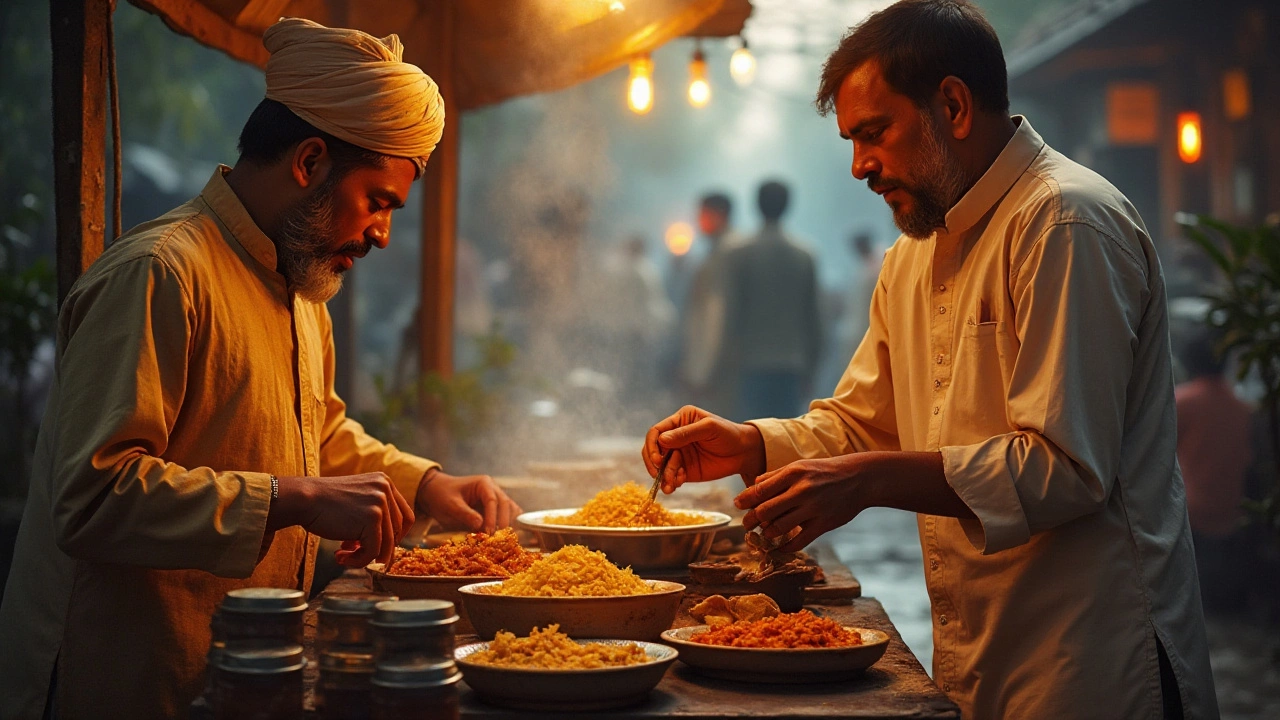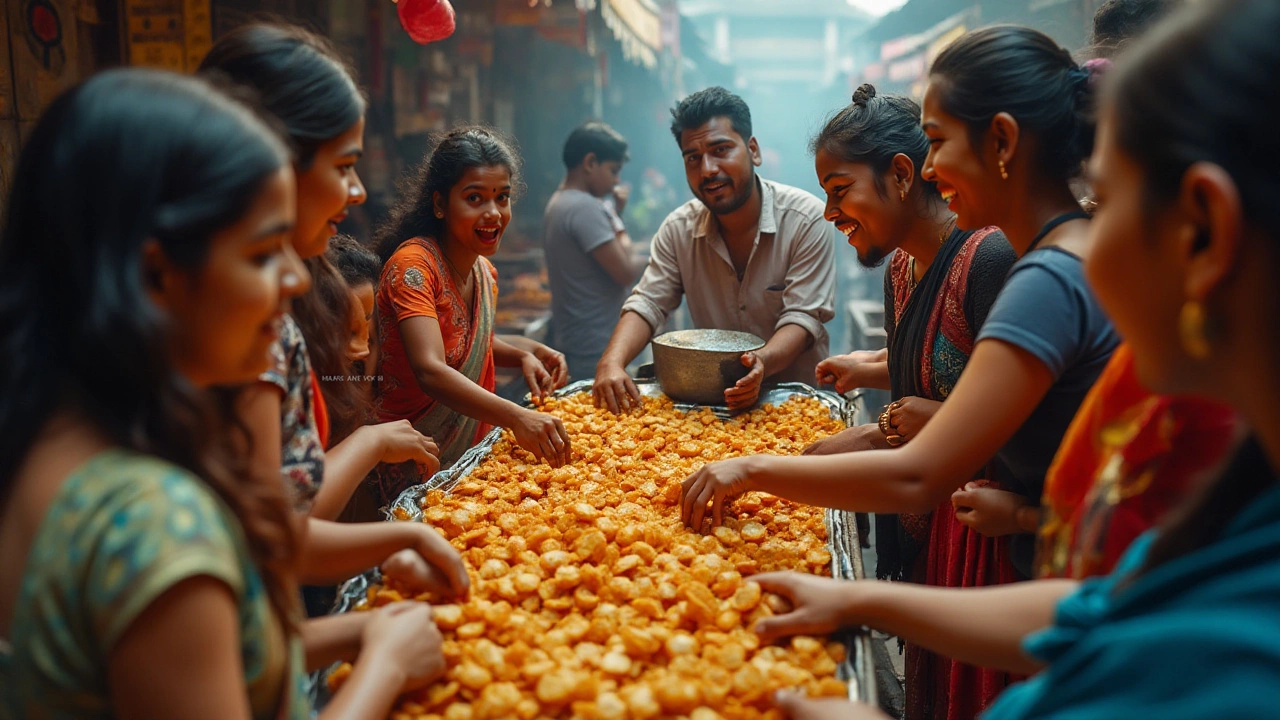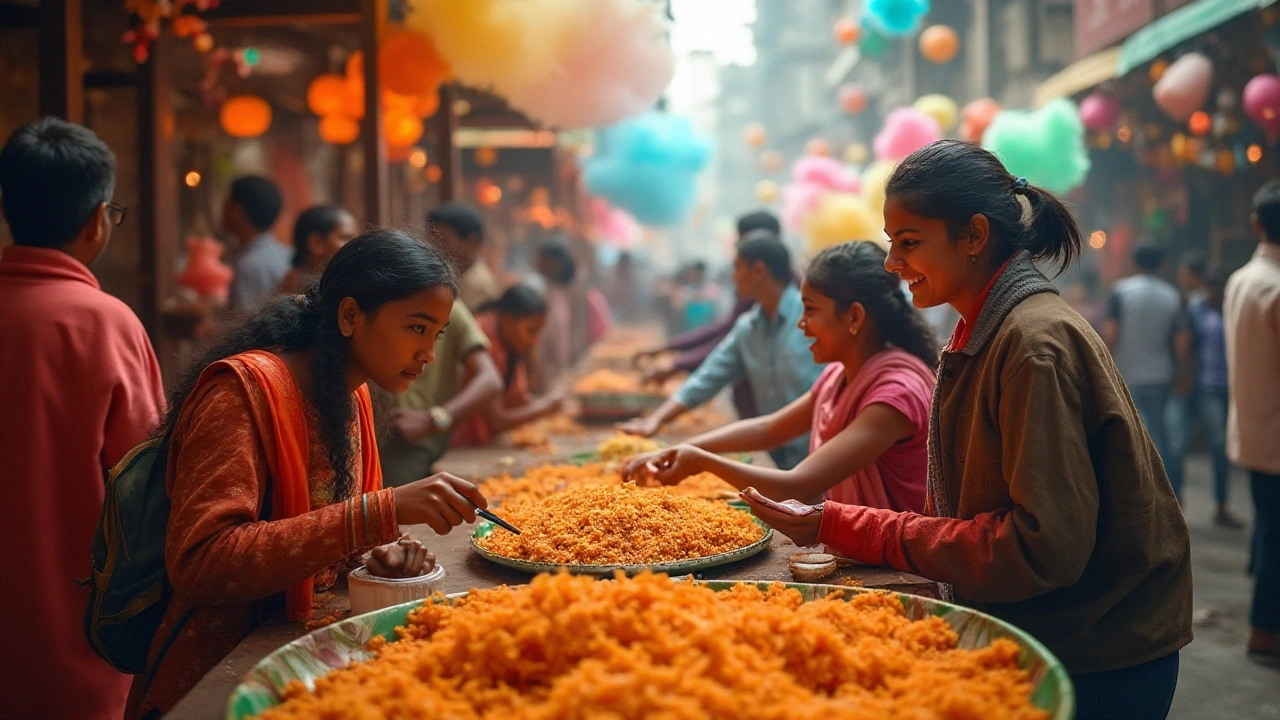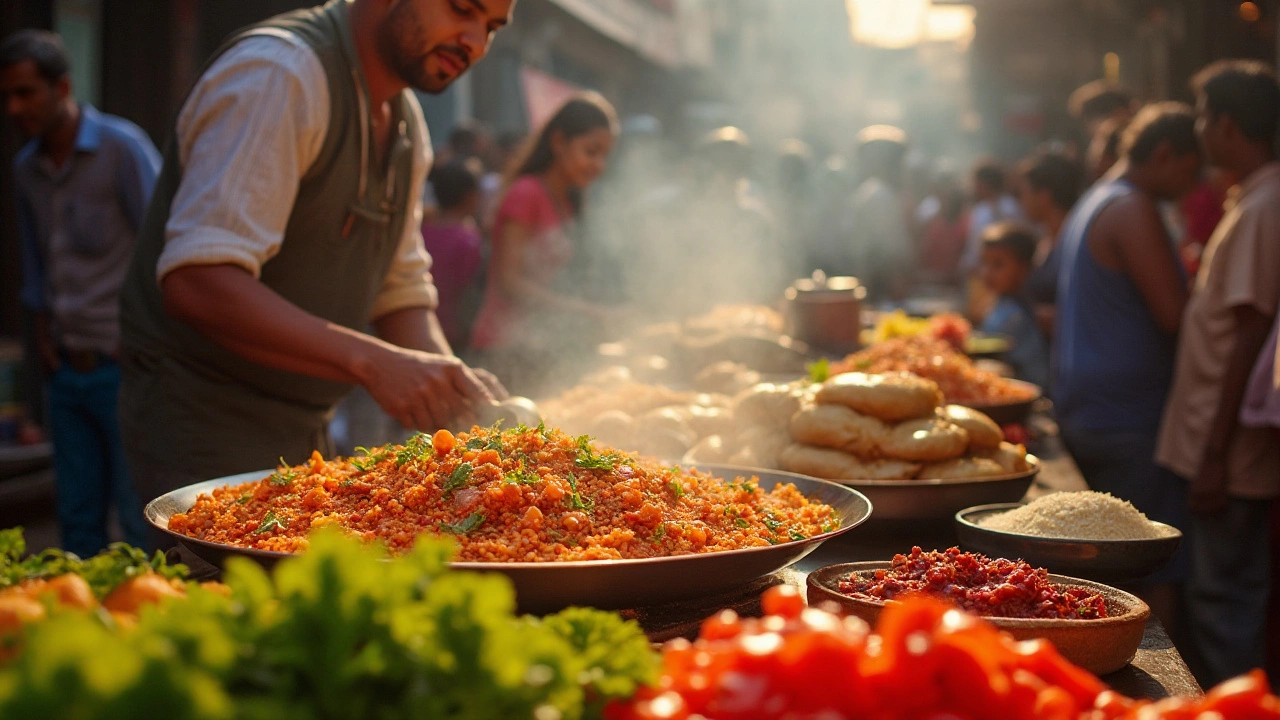Embarking on a street food quest in India can be both exhilarating and overwhelming. The lively markets, the inviting aromas, and the vibrant colors beckon food lovers from around the world to explore a veritable feast for the senses. However, amidst this culinary adventure, there lies an underlying layer of tradition and etiquette that enhances the eating experience.
Knowing how to immerse oneself in this rich tapestry of flavors while respecting cultural norms can transform an ordinary meal into something extraordinary. Whether you're savoring spicy chaat or indulging in a sweet jalebi, appreciation for local customs goes a long way. Dive into this guide to not only satisfy your palate but also to enrich your understanding of this fascinating culture.
- Understanding Eating Etiquette
- Navigating Regional Foods
- Hygiene and Safety Tips
- Engaging with Local Vendors
Understanding Eating Etiquette
When it comes to experiencing Indian street food, it's more than just about the food on your plate. This journey requires an understanding of the local culinary etiquette that is deeply embedded in the region's cultural roots. Each bite is a sensory delight, but how you go about eating it can say a lot about your respect for the local traditions. The street vendors bustling along lanes in places like Delhi and Kolkata aren't just about serving food; they are preserving a piece of their cultural heritage. Despite the chaotic hustle and bustle that typically characterizes these streets, there is a certain order and code of conduct that locals and tourists alike follow. Engaging in this unwritten code not only enhances your eating experience but also shows your appreciation for the rich traditions you are contributing to.
One of the fundamental customs in India, which might seem unusual to travelers, is the practice of eating with your hands. This traditional method is considered an intimate way to savor each flavor and texture of the meal. It's said that eating with your fingers not only satisfies hunger but connects you with the food and the moment. However, it's important to remember to only use your right hand, as the left hand is traditionally reserved for other bodily functions. This practice holds significant importance in regional foods throughout the country and stems from ancient beliefs that focus on cleanliness and authenticity.
"The true joy of eating lies in the appreciation of flavors that both imperial and humble foods present, and in India, this is a community experience," says acclaimed Indian chef Madhur Jaffrey.
Dining at street stalls often means standing while you eat. The limited seating doesn't detract from the experience; instead, it adds to the charm and authenticity. Sharing space with locals and watching the street chefs in their element can be as rewarding as tasting the food itself. When out and about in crowded market areas, you might notice how people exchange polite greetings before eating. A simple smile or nod can open the door to an enriching conversation about the dish's history and preparation, unraveling stories that connect you to India's culinary heart.
Balancing cultural expectations with modern practices can be tricky, especially for first-time visitors. It's common to see a mix of traditional and contemporary practices coexist harmoniously. For instance, paying vendors with cash is still preferred over digital transactions, even though digital payment options are becoming more frequent. Respect and politeness form the backbone of social interactions, and how you conduct yourself can leave lasting impressions on the local vendors who are proud ambassadors of their culinary crafts.
For adventurers ready to delve into the diverse flavors of Indian street food, understanding eating etiquette is as crucial as choosing the dish itself. It's this mindfulness that enriches the entire experience, turning a simple snack into a memorable adventure. These practices, built over the centuries, offer more than just a guide to respectful eating—they provide insight into the heart of Indian culture. So when you stand before a vendor cooking up a sizzling delicacy, know that with each bite, you are not just tasting food but partaking in a tradition that stretches back through generations.

Navigating Regional Foods
India's street food scene is as diverse as its culture, with each state and city boasting its own unique offerings. As you traverse this vast nation, it's essential to understand that each region's street cuisine highlights its distinct ingredients, flavors, and cooking techniques. For instance, the coastal areas serve seafood-centric delights, while the northern plains are famed for hearty and rich snacks like chole bhature and samosas. The Indian street food landscape is a smorgasbord of tastes waiting to be discovered, an experience that lingers long after the flavors have faded. Each bite tells a story rooted in ancient traditions, local produce, and the art of simple yet impactful cooking.
In southern India, dosa stalls rustle up crispy rice and lentil crepes often served with coconut chutney and spicy sambar. These thin delicacies have variations such as masala dosa, stuffed with a filling of spicy potatoes, nature's way of showing how humble ingredients can create a memorable meal. Journeying northwards to Punjab, you'll encounter the smoky, aromatic allure of tandoori chicken and buttery naan fresh out of the tandoor. Such dishes are not just food; they are a celebration of centuries of culinary evolution.
One can find that each metropolitan area has developed its innovative fusion of traditional regional foods with cosmopolitan influences, serving as a melting pot of flavors. Street vendors in Mumbai, for example, dish up vada pav—a spiced potato patty sandwiched in a bun—which is affectionately dubbed the city's own desi burger. Chennai offers its quintessential idlis, beloved rice cakes served with tangy sambar, perfect for a light snack or a heavy breakfast alike. Venturing into the heart of Delhi, you cannot miss the chaats, a delightful melange of crispy, tangy, sweet, and spicy elements—puri, tamarind chutney, and chilled yoghurt meld into a singular, delightful medley.
"India's street food offers a window into the country's soul, combining thrift with flair, tradition with invention," shared Madhur Jaffrey, renowned food writer and actress, articulating the essence of experiencing street cuisine with an open heart.
The diversity doesn't stop at the ingredients; it's also about the experience. In Rajasthan, you might find a vendor preparing street-side dal baati churma, where the preparation includes elaborate steps and a hearty serving. On the contrary, in the eastern parts like West Bengal, vendors specialize in jhal muri, a spiced puffed rice mix that's quick to prepare yet deeply satisfying. Understanding these local specialties is part of the thrill of navigating street food in India, and knowing a bit of the local language or customs can go a long way in enhancing your eating experience.
To reap the full benefits of this culinary journey, it's worth embarking with a hearty appetite and a robust sense of adventure. Discovering the food stalls that locals patronize is often the key to understanding what makes a particular regional food shine. The chatter, the aroma, and the informality combine to form what can only be described as pure, undiluted joy. As always, a discerning eye and a patient ear can make significant differences in deciphering the nuances of Indian street food and appreciating them fully, making each meal an unforgettable part of your travels.

Hygiene and Safety Tips
When it comes to exploring Indian street food, ensuring hygiene and safety can make your dining experience both delightful and worry-free. While the street vendors present a culinary treasure trove, the key to enjoying these delicacies without any hitch lies in making informed choices. A good starting point is to observe how food is being prepared and served. Vendors who handle money and food simultaneously without washing hands might not maintain the best hygiene practices. Look for places where vendors use gloves or utensils to handle food, as this indicates a higher level of cleanliness which is crucial in maintaining food safety standards.
Another useful tip is to eat where there's a high turnover of customers. Busy stalls mean the food is fresher since it's cooked more frequently and hasn't been left sitting out for long periods. This not only ensures a flavorful bite but reduces the risk of encountering stale or contaminated food. Try to approach food stalls during peak hours for the freshest servings and a safer experience. Moreover, ensuring that your food is thoroughly cooked reduces the risk of consuming anything that's undercooked or potentially harmful. Certain items like chaat or fried samosas are best enjoyed hot, straight from the fryer, adding to both taste and safety.
"Food safety is like a conversation with a stranger—approach with curiosity, observe intently, and proceed with what feels right." - Dr. Aruna Shetkar, Food Safety Specialist
Water and Drinks
Special attention should be paid to the water used in preparing drinks or rinsing foods, as contaminated water can be a source of diseases. A handy rule of thumb is to avoid ice in drinks unless you can be sure it was made with filtered or packaged water. Opt for bottled or canned beverages, as they are usually safe across India. Drinks like lassi and fresh sugarcane juice might tempt you, but consider the cleanliness of the utensils and the purity of the water before indulging.For those keen on trying out local beverages, look for stalls where drinks are freshly prepared in front of you. This ensures that ice is made from bottled water, minimizing the chances of contamination. Also, try to carry hand sanitizers and wet wipes, as they come in handy after holding currency, which is exchanged frequently and can be a breeding ground for germs. A simple habit like cleaning your hands before eating can significantly enhance your street food experience.
Being Prepared
Finally, a proactive step is to pack some over-the-counter medication for common ailments like an upset stomach or mild food allergies, which can be a lifesaver in a new or unfamiliar environment. It's also wise to familiarize yourself with any food allergies you might have and avoid ingredients or dishes that might trigger them. This forethought ensures that you can dive into India's vibrant street food culture without any fear. Remember that the joy of street food lies in its exploration and discovery, and being prepared only heightens the pleasure.
Engaging with Local Vendors
Interacting with local vendors while enjoying the delightful Indian street food transforms your eating experience from a simple transaction into an engaging cultural exchange. The streets of India are alive with the sounds of haggling, friendly banter, and the sizzling of hot grills, each vendor offering a story as rich as the food itself. Building a connection with these vendors not only enhances your tasting journey but also gives you insights into the deep-rooted traditions of India's culinary world, which has seen a blend of various regional food identities over centuries.
Start by greeting the vendor with a smile or a simple 'Namaste,' which is both polite and well-received. You'll find that many vendors are genuinely enthusiastic about sharing the history or secret ingredients behind their signature dish. It is this personal touch that often leaves a lasting impression. With each bite of spicy pani puri or the fragrant pav bhaji, you partake in an exchange of culture and history, woven together by the vendor's narrative. Navigating language barriers is simpler than one might anticipate, as food has its universal language; gestures or the chance to watch a dish prepared often suffice to bridge any gaps.
"Food is not just about taste or preparation; it's about the conversation that accompanies it," says a renowned Indian culinary writer.
When engaging with vendors, showing respect for their skill and craft goes a long way. Ask them questions about their food, their inspiration, or the fresh ingredients they use, and you'll often be met with a passionate response that reveals a deeper understanding of India's culinary treasures. It is fascinating how an understanding nod or an appreciative comment can ignite a dialogue, which often leads to recommendations for other must-try spots or dishes you might have otherwise overlooked. By keeping the conversation light and positive, you'll see that vendors are more inclined to share those insider tips that guidebooks cannot provide.
Another consideration is to be mindful of the time you engage with a vendor, especially during peak hours when they might be catering to a flurry of customers. Most vendors appreciate concise interactions and a genuine interest that doesn't hold up their busy period. If you're visiting during a less hectic time, however, feel free to linger longer to learn more. Paying attention to cleanliness and food preparation standards is crucial for a pleasurable experience. Many vendors take pride in maintaining their stalls, incorporating best practices in hygiene, yet subtly recognizing one's surroundings aids in selecting where to eat safely.
Leaving a small tip is often appreciated by vendors who may depend heavily on daily cash flow. As you savor the vibrant street cuisine, rewarding good service helps sustain these micro-economies, allowing them to thrive amid globalization's challenges. For many tourists, this serves as a moment of reflection on the resilience and dedication of local food artisans who continue to nurture the heart of India's streets, one delicious dish at a time. Lastly, don't forget to express gratitude, which reinforces the mutual appreciation between a traveler exploring regional foods and a vendor passionate about their craft.
